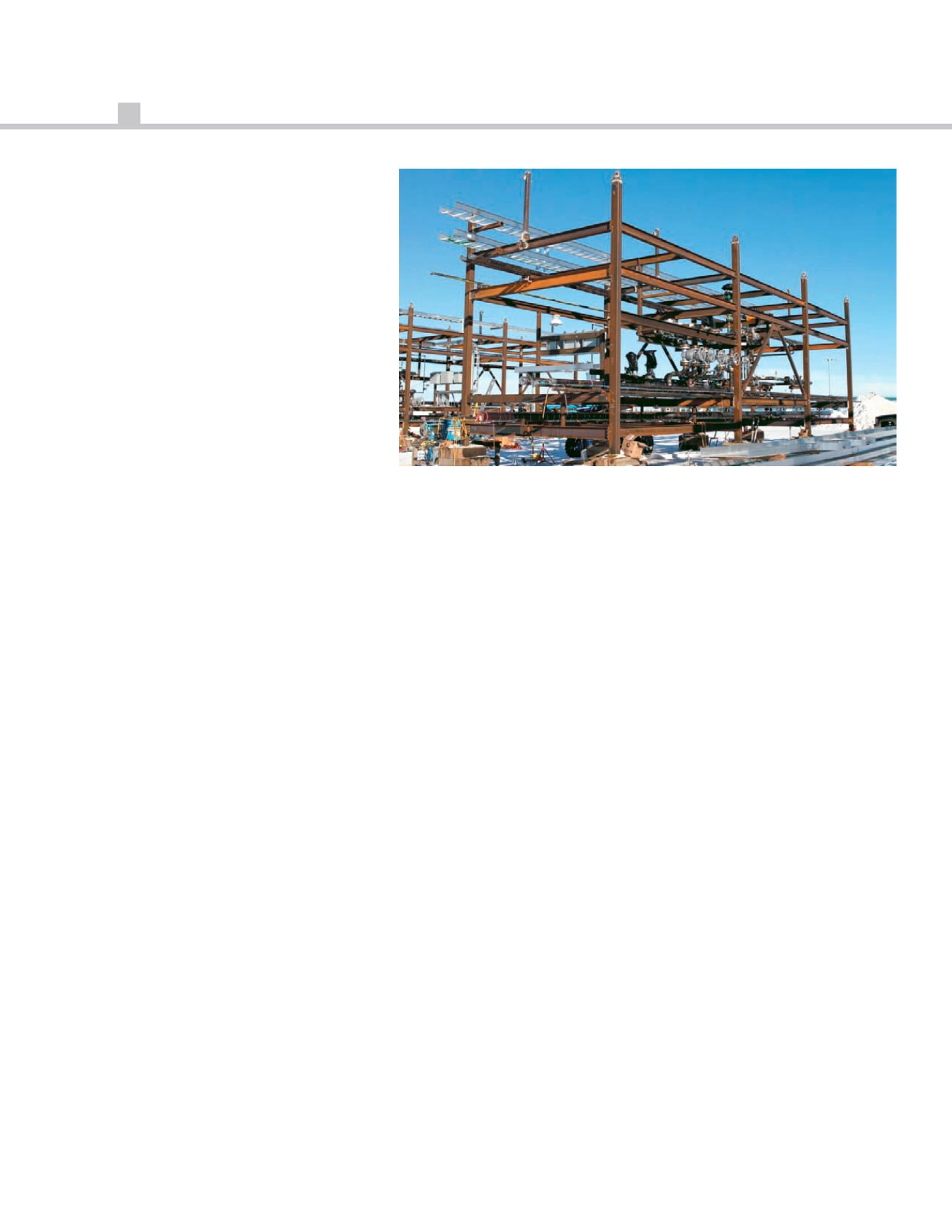
14
together intoa labonsiteatgreater
speedand lowercost.
WhenArizonaStateUniversity
contemplated itsvision foraVariable
AtmosphereLaboratoryconceivedasa
premier facility forclimatechange
research, aconceptwasdeveloped for
smallmobilechambersdubbed
“miniworlds” inwhichatmospheric
composition, temperature, humidity,
UV radiation, atmosphericpressureand
lightcyclescouldbecontrolledwith
much lesscarbon impact thana
traditional labconstructionapproach.
Ineachof thesecases, ownerssought
the inherentbenefitsofmodularity’s
highlyadaptable, flexible, durable,
energy-efficient, “plug-and-play”
characteristics—thesame
characteristics thatmake themodular
approachagood fit fordatacenters
when implementedproperly.
Likea lotof innovativeapproaches, the
modulardatacentermovementhada
fewdistractions from itsprimary
missionas itevolved from its fledgling
prototypephase intosecond
generationstatus. In the relative
handfulofyears from2007 to today—
less thanadecade—the leadersof
modulardatacenter innovationhave
doneanadmirable jobofaddressing
shortcomingsassociatedwith first-
generationmodels. Someof those
initial concerns included:
Energyefficiency.
Was itall itwas
crackedup tobe inmodulescompared
toconventional stickbuilt structures? In
somecases theenergysavingssimply
didn’tprove tobe thatgreat.
Damage tomodularunits resulting
from impropershippingand
installationpractices.
Someunits
turnedout tohavedisappointing
resistance toweatherization, reliability,
and thequalityof lifesafetysystems
suchassmokedetectionand fire
protection.
Maintenance.
Manymoduleswere
designedwithequipmentpackedso
tightly thatmaintenancewas required
tobeperformed fromoutside theunit.
Thisofcourse invitescompromising
internalmodularenvironments, andcan
insomecases requireunitdowntime,
ananathema in thedatacenterworld.
Somemodularmodelshavecomplex
infrastructureconfigurations requiring
theskillsofacontortionist tonavigate,
whileagainposingapotential threat to
continuityofoperation.
Regulatory issues.
Whenare these
unitsconsideredpiecesof “equipment”
andwhenare they “buildings?”
Interpretationsofcode issuesvary
widely fromone jurisdiction toanother
around theworld.Howcananowner
knowwhat regulatory requirementswill
be imposedonamodularunit inagiven
location?
Customizationofcomponents.
Many
modularunitsareequippedwith
standardizedsizingofUPS,mechanical,
electrical andservercomponents. This
hascausedconcerns forownerswith
unique technical requirementsor
challengingclimateconditions.
Thankfullymanyof theseconcerns
havebeenaddressed in themodular
second-generationera.
PowerUtilizationEffectiveness (PUE)
rateshavebecomemoreattractive in
modulardesignsascoolingstrategies
havegottenmorecreative. Someair
handlingschemesareuniqueenough to
warrantpatentprotection.
Conventionalmodulardatacenter
approachesdesigned for spaces the
sizeof standardshippingcontainers
oftenstruggle tomusterenough
coolingpower tosupporthigher-
densityservers.Manyconventional
modularcontainersarealsounable to
adequately functionat the lowerendof
the thermal spectrum in temperatures
below30˚F.
Onemoduleoptionhas introduceda
proprietaryaireconomizermixingbox
designcapableofmixingcoldoutside
airwithwarmserver returnairwhile
providingauniform temperatureacross
the full faceof the IT racks. Thisattacks
achronicproblem indatacenter
coolingover theyears—thedifficultyof
mixingwarm returnairwith large
volumesofcoolmakeupair, sincewarm
andcool air layers tend tostratifyand
resistmixing. Throughacombinationof
sizingandpositioningofairconduits,
airvelocities, plenums, airdivertersand
louvers, breakthroughefficiencieshave
beenachieved in themixingofwarm
andcool airstreams.
Thesusceptibility todamageduring
shipping isaconcerncomparable to
thecareall consumersmustexercise
whenarranging theshipmentof
vulnerable items, suchas themillionsof
breakableglassproducts thatare
successfullyshippedaround theworld
everyday. Improvedmodular shipping
methodshavesafeguardssuchas
sensors thatcandetectand remotely
monitor shippingconditions.Or for
added reassurance, shipmentof
modularunitscanbeclosely
supervisedbymanufacturers toassure
safedelivery. Suchprecautionsmay
costabitmore, but they reduce the risk
andapprehension that someowners
havehad related to transporting
modularunits, especially
internationally.
Thereare twokindsofpurveyorsof
modulardatacenters; those thatmake
thesaleandwalkaway, and those that
remain involvedwithabuyer toassure
thatutility infrastructure is inplaceas
well asassuring that shipping, delivery
andsetupofunitsareperformed
properly.Buyersneed tounderstand
thatoneof thepricespaid for themany
advantagesofmodulardatacenters is
duediligence in thedeterminationof
how infrastructurecanbeprovisioned
tosupportmodularunits, howunitswill
beshippedandwhowillbeonhandat
the receivingend tomakesure theunits
aresafely transported, installedand
made fullyoperational at theirend
point. Therearemodulardatacenter
7X24MAGAZINE SPRING2014


